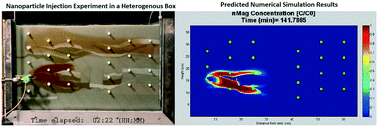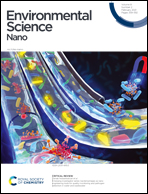Development and experimental evaluation of a mathematical model to predict polymer-enhanced nanoparticle mobility in heterogeneous formations†
Abstract
Successful application of nanoparticle (NP)-based subsurface technologies strongly depends upon NP mobility, which can be severely limited in the presence of fine materials (e.g. clays), high temperature, and/or saline conditions. Our previous investigations demonstrated the potential for relatively small additions of commercially available polymers and surfactants (e.g., Gum Arabic (GA) and Calfax 16L-35) to significantly improve NP mobility in homogenously packed columns. In this study, a multi-constituent site blocking modeling framework was refined and implemented in a three-dimensional, multi-constituent flow and transport simulator to describe the effects of GA on the mobility of polymer-coated magnetic iron oxide NPs. A series of column experiments was conducted to independently obtain model input parameters, including NP attachment and GA sorption capacities and rates, from measured effluent breakthrough curves. Column effluent concentration data demonstrated that NP mobility increased by up to 2.47-fold with co-injection of GA (1000 mg L−1). Multi-dimensional model simulations of NP transport and retention in a heterogeneous flow cell experiment reveal that the numerical model is able to capture enhanced transport of the NP plume in the presence of GA and to predict measured NP concentrations at sampled locations with the coefficient of determination (R2) of 0.82 across all observations. A sensitivity analysis, exploring the potential effect of pore velocity variations on attachment parameters, revealed that NP mobility was most sensitive to the velocity dependence of the attachment parameter in the finest medium (crushed sandstone), with a potential decrease in NP mass recovery of up to 26%.



 Please wait while we load your content...
Please wait while we load your content...